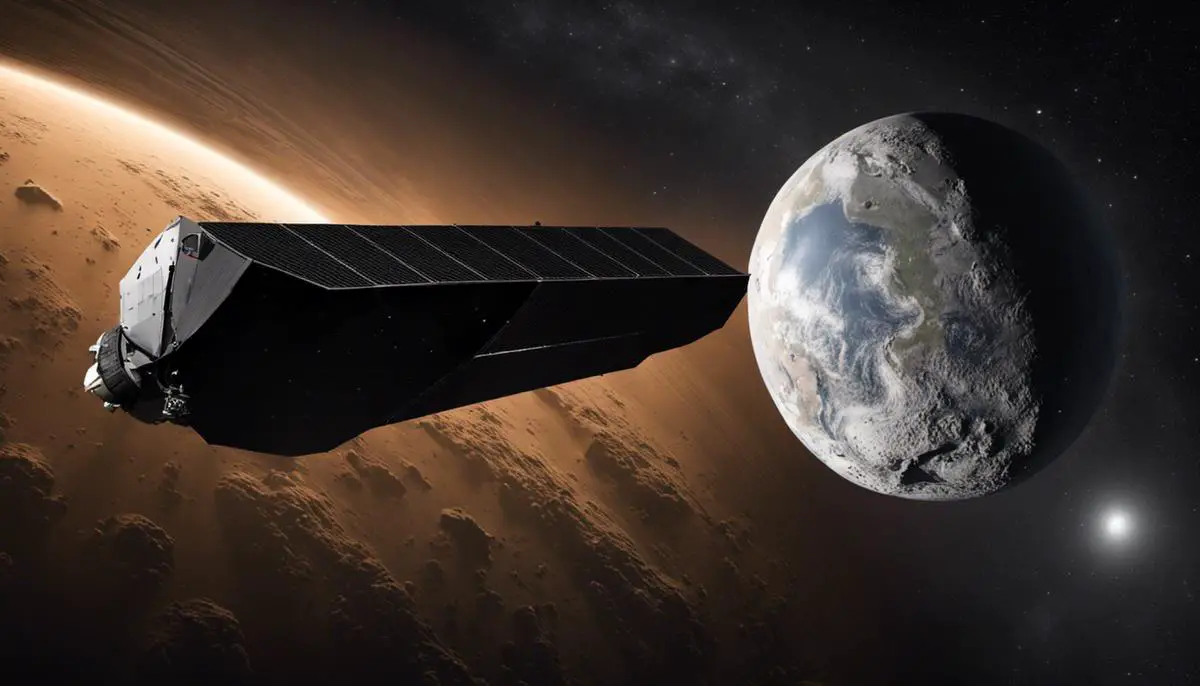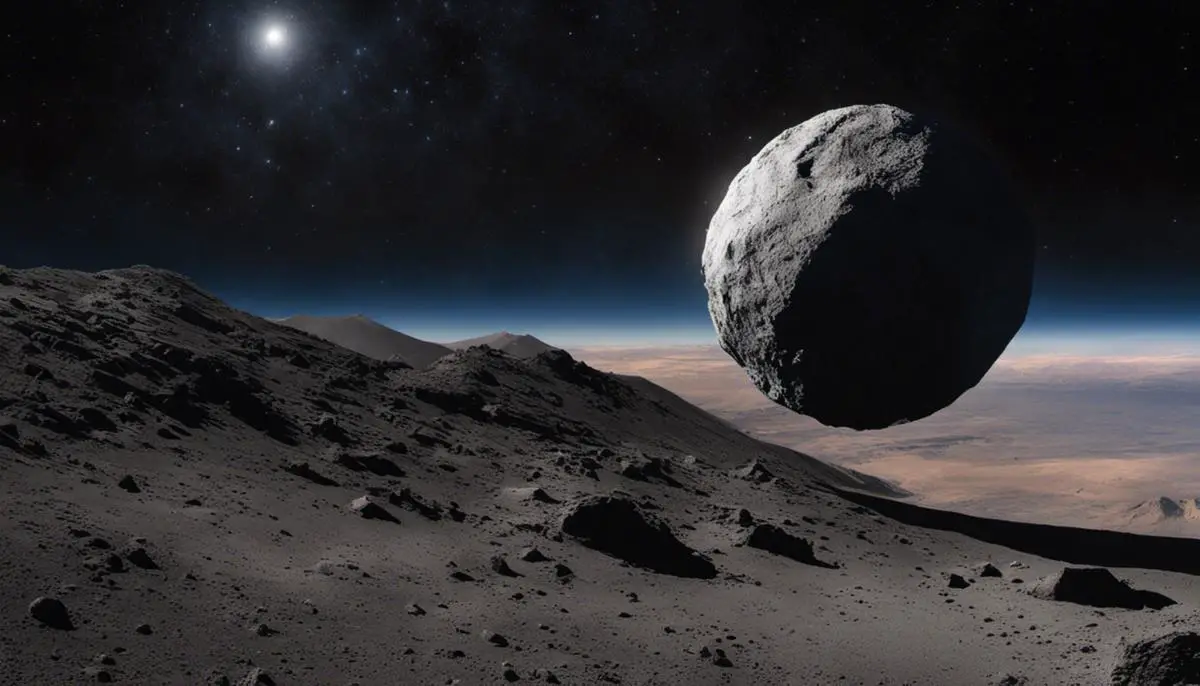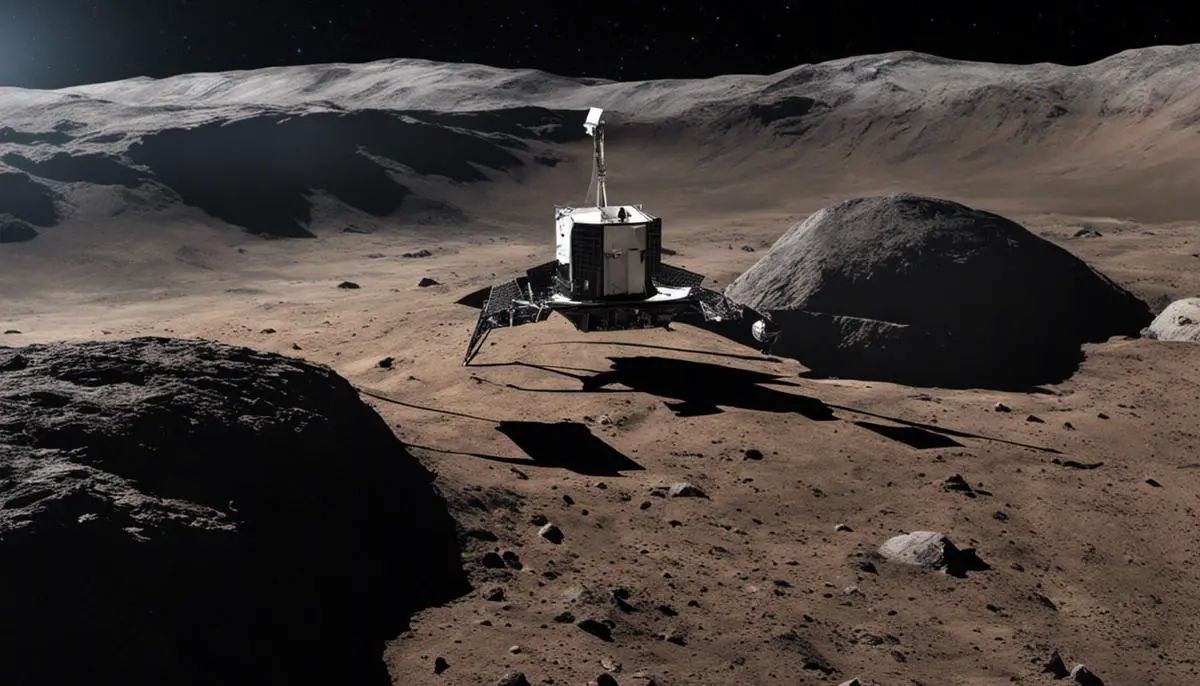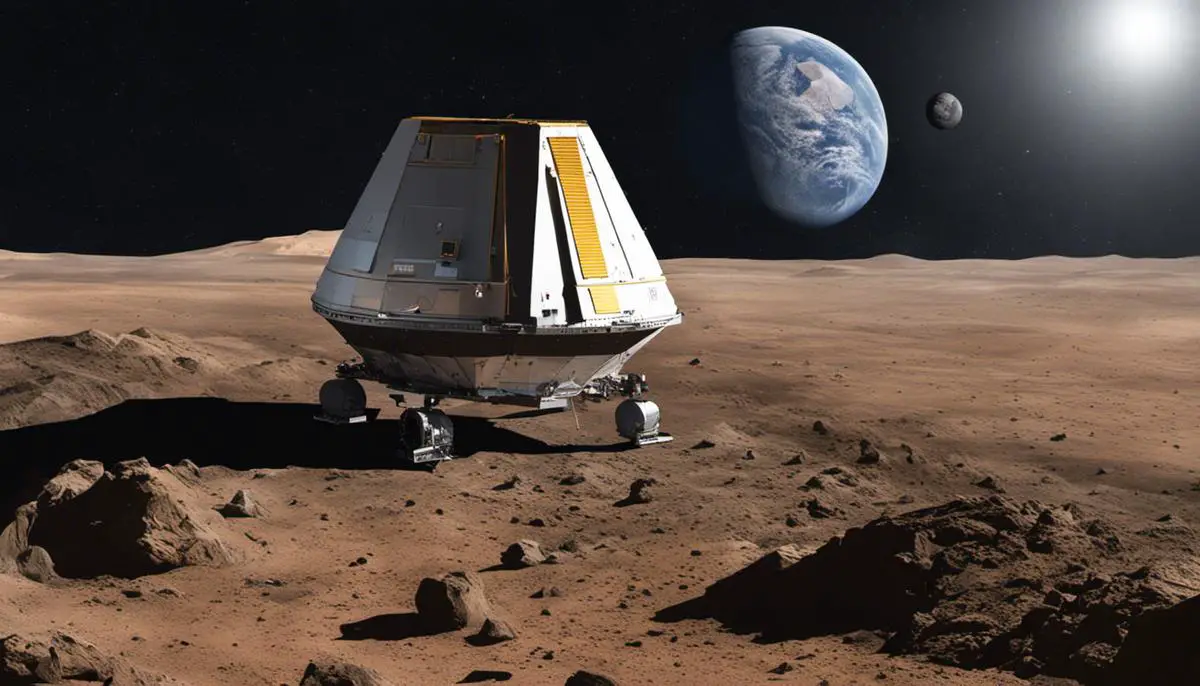The cosmos remain a menagerie of secrets and unanswered questions, inspiring mankind to push beyond the horizon of earthly knowledge. NASA’s audacious mission to Bennu, embarked upon by the OSIRIS-REx spacecraft, is an embodiment of this insatiable curiosity. In this review, we delve into the intricacies of this out-of-world mission, breaking down its sequence from launch to sample return. A close examination of the onboard scientific instrumentation provides insight into the elaborate mechanisms enabling this exploration. Exclusive features of Bennu, its variegated physical and chemical attributes, and the mission’s potential implications on the understanding of life’s origin on Earth will be investigated. Lastly, we shed light on the hurdles that NASA has encountered, achievements thus far, and the promising possibilities the mission holds for the future.
Mission Overview
Unraveling the Innate Purpose of NASA’s Bennu Expedition: A Grand Tryst with Asteroid Science
Embarking on a parabolic mission of paramount significance, the National Aeronautics and Space Administration (NASA) showcases yet another reverberating instance of human audacity to explore, understand, and bridge the scientific chasm that has long-perplexed researchers: it’s an ambitious endeavor dubbed “the mission to Bennu”.
Bennu, an asteroid traversing aloofly through the cosmic void, has piqued intrigue from the scientific consortium. The expedition to Bennu has its inception rooted in the ceaseless desire to comprehend the nascent stages of our cosmos, thereby excavating the cradle of life on Earth.
Operating on the fringe of potential and propensity, NASA’s OSIRIS-REx (Origins, Spectral Interpretation, Resource Identification, Security, Regolith Explorer) spacecraft gears up to delve into Bennu’s substantial reservoir of primordial remnants. By extracting these unadulterated astrological archives, embedded deep within Bennu’s topographical tales, the mission envisions answering age-old queries about the birth of celestial bodies and the genesis of life.
Hand in glove with these stellar objectives is the imperative necessity to boost terrestrial security. Bennu’s orbital linearity juxtaposed with that of Earth rings the occasional cosmic warning bell of a potential “doomsday scenario”. Piecing together Bennu’s physical composition, its orbital dynamics, and the Yarkovsky Effect (the radiation –force driven alteration in an asteroid’s path), NASA seeks to engineer effective deflective mechanisms, therefore fortifying the Earth from future asteroid collisions.
Supplementing these core tenets, the mission’s concurrent auxiliary motive unravels the economic implications of asteroid mining. The scientific fraternity believes that asteroids like Bennu hold untapped reserves of precious metals and water – components of quintessential worth for future deep space expeditions.
The expedition to Bennu is indeed a challenge of astronomical proportions. It demands the synchronization of advanced dynamics, precision-led maneuvering, and groundbreaking scientific acumen. However, investigating the black and white of the deep unknown charts a revolutionary trajectory for ongoing cosmic scholarship. It fuels the spirit of inquiry and discovery, bolstering the pathways that lead to groundbreaking research and innovation.
Undoubtedly, our understanding of the universe, and with it, the foundation of astrological science, is at the cusp of an extraordinary revolution, thanks to NASA’s unrivaled determination. With Bennu’s veneration, our perception of the cosmos transcends the horizon of existing knowledge, propelling the genesis of an enlightened era of astronomical wisdom. NASA’s journey to Bennu, therefore, serves as a beacon of hope and testament to human resilience in the quest for perpetual wisdom. It’s not just a mission, but a fascinating story of discovery, unearthing the ultimate cosmic truth. Indeed, a grand tryst with asteroid science beckons.

Scientific Significance
Harnessing the potential of Bennu as the target for NASA’s mission is an intricate blend of curiosity, pragmatism, and intellectual intrigue.
Bennu, a primitive, carbon-rich body that stands as a remnant of the ancient solar system, delivers the unique opportunity to create a detailed geological map.
It enables not just an exploration into the origins of life, but also provides insight into the early evolution of our planet, leading to the development of a more nuanced comprehension of our space environment.
The scientific allure of Bennu—apart from its proximity and potentially hazardous orbit—is deeply entwined with its carbon-rich composition.
Rich in elemental and molecular precursors, Bennu effectively narrates the story of a young solar system, offering invaluable clues about the physical and chemical processes that led to the formation of planets, and possibly, even life.
By delving into the history etched on Bennu’s intriguingly dark surface, the mission hopes to bridge the understanding of the formative processes of the early solar system to the existence of life on Earth.
Yet, this mission is not merely an investigation of the past.
By advancing our knowledge of both the physical and chemical properties of asteroids like Bennu, the mission could help shape the future of planetary defense strategies.
This orbital ‘detective’ work is crucial for estimating the sizes, compositions, and other properties of other near-Earth Objects (NEOs) that might pose a threat to our home planet.
Moreover, Bennu’s rich composition also bears the tantalizing promise of space resources.
It is a well-recognized fact that asteroids contain a plethora of useful materials.
NASA’s mission to Bennu lays the groundwork for possible future resource utilization, which could revolutionize our approach to space exploration, supporting long duration, deep-space missions.
Another aspect of the mission extends beyond the asteroid itself.
The methods and technologies developed and refined for this mission will enhance our capability to reach, study, and even manipulate other celestial targets.
Innovative technologies such as the OSIRIS-REx spacecraft’s Touch-and-Go Sample Acquisition Mechanism (TAGSAM) illustrate the ongoing advancements in robotic precision and dexterity.
In summary, it can be appreciated that Bennu is not just an asteroid but a window—opening up vistas into our cosmic past, while also lighting the way for our future in space.
In pursuing these fundamental questions about our universe, the mission forwards our quest for knowledge, and by extension, our very comprehension of existence.

Challenges and Milestones
As the Odyssey to Bennu has taken significant strides, it is incumbent to explore the challenges faced and the breakthroughs that have happened so far. The mission to Bennu, unlike any other, not only aspires to solve the underlying mysteries of the cosmos but also seeks to reveal whether the keys to life’s origins are hidden within these celestial formations.
One of the most significant challenges has been capturing a sample of the asteroid. Bennu’s rough, boulder-covered surface presented unexpected complexities, profoundly testing the spacecraft’s precision navigation techniques. Since collecting a sample required a precise touchdown within a radius of a few meters, these surface conditions necessitated the development and implementation of a more sophisticated autonomous navigation software system.
Yet, out of these difficulties came a groundbreaking achievement. Using its natural feature tracking navigation system, the spacecraft performed a dramatic descent, briefly made contact, and successfully collected a sample. This remarkably accurate operation has not only been a crowning moment and an unprecedented success for NASA but also an essential stepping stone towards more advanced missions of this nature.
Another significant challenge entails the safe return of the sample to Earth. The dispatched spacecraft, which is millions of miles from Earth, is entrusted with the safe delivery of priceless scientific information. While the journey remains ongoing, technology and mission planning continue to provide solutions to ensure the sample securely reaches Earth.
Astoundingly, an unexpected discovery of particles being ejected from Bennu’s surface, an uncommon phenomenon among asteroids, has underscored the mission’s breakthroughs. This surprising observation has deepened our understanding of asteroid behaviors, revealing a facet of their dynamism hitherto unfamiliar to astrological scientists.
Analysis of early data from the spacecraft’s approach to Bennu also unveiled a further breakthrough: water locked within the asteroid’s clay minerals. While the presence of water on asteroids has been suspected, its confirmation on Bennu may offer insight into Earth’s ancient hydrosphere’s formation and evolution.
Further, the mission aided the demonstration and testing of myriad scientific instruments and strategies, all of which can be employed in future missions. These include LIDAR for comprehensive topographic mapping and spectrophotometry techniques to determine Bennu’s composition.
In essence, the journey to Bennu has served as a fitting encapsulation of the scientific process – a consistent interplay of challenge and discovery. Each obstacle, each unexpected finding adds another layer to our understanding, not just of Bennu, but of the functioning of our own planet and the broader universe. As the quest continues, it bears testimony to humanity’s ceaseless pursuit of knowledge and our determination to look beyond the frontier of the familiar. The challenges and breakthroughs in the Bennu mission so far, underpin the reality that space exploration is guided as much by unanticipated problems as by planned goals, reaffirming that science is a fusion of prediction and serendipity.

Future Implications
The potential implications of NASA’s Bennu mission findings are multilayered and carry profound impact. In the context of future explorations, the groundbreaking success of collecting an asteroid sample proves the technological feasibility of such missions. Additionally, the successful deployment and operation of autonomous navigation systems pave the way for more sophisticated, remotely challenged space endeavors. This represents not just a technological leap, but also a paradigm shift in how we can approach space exploration.
The detection of water within Bennu’s clay minerals provides strong supporting evidence for theories that posit the role of asteroids in bringing water – and by extension, life – to the Earth billions of years ago. More importantly, it shows that potential building blocks of life exist beyond our planet. This reaffirms the importance of studying asteroids as it pertains to the origins and the evolution of life, making missions like the one to Bennu crucial components of astronomical research.
Simultaneously, the Bennu mission underscores the valuable insights which can be gleaned from examining more closely our celestial vicinity. Through an in-depth understanding of objects within our solar system, we can grasp complex phenomena like planetary formation, thereby advancing our understanding of the universe.
Bennu’s unpredictable particle-ejection phenomena denotes one of the many unexpected challenges that space missions can confront. It further illustrates the delicate interplay between meticulous prediction and fortuitous discovery that marks all great scientific expeditions. This challenges us to adopt a holistic research design that encompasses an awareness of the unexpected and an agility to adjust accordingly.
Moreover, future missions can benefit from the technological advancements developed specifically for the Bennu mission. These technologies include the OSIRIS-REx’s tagSAM (Touch-and-go Sample Acquisition Mechanism) and navigation systems, opening up a wealth of opportunities for exploring harder-to-reach or previously uncharted celestial bodies.
As it relates to Earth’s safety, the Bennu mission aptly demonstrates the feasibility of ‘Planetary Defense’. By understanding more about Bennu’s composition and trajectory, we have already embarked on this path. This mission has further enabled us to identify potentially hazardous asteroids and develop their deflection mechanisms, necessary steps for mitigating potential asteroid impacts on Earth.
Ultimately, these insights gleaned from Bennu make us more equipped for future space explorations, help chart safer navigation paths for space missions, and prepare us better against celestial threats. It reiterates the imperative of space explorations, the lessons from which transcend our understanding of cosmic bodies and extend to protecting our own.

The journey to Bennu is not only an intricate ballet of cosmic proportions, but also a testament to human ingenuity and determination. From unveiling secrets of our solar system’s origins to paving the way for asteroid mining, the OSIRIS-REx mission catapults us towards uncharted frontiers. It is through endeavours like these that we interrogate the titanic cosmic bodies for answers, consequently enriching our understanding of the universe that birthed us. Whether it’s mitigating impending asteroid impacts or the potential of extraterrestrial colonization, the insights acquired from this endeavor are stepping stones to a future well beyond terrestrial confines. Wrapped up in the quest to Bennu is our drive for comprehension, our indomitable spirit, and the undying prospect of human advancement.
![]()
